A well-implemented social media marketing strategy comes with endless perks. If you need help, I’ve compiled the effective social media marketing strategies that can improve the effectiveness of your marketing efforts this 2022.
For over a decade as a small business owner, I’ve used different tactics in my social media marketing campaigns to establish my brand name and reach my ideal customers. Some fail to deliver outstanding results, but most achieve success and open many opportunities for my brand and products.
I’ll discuss the best social media marketing strategies to save you time. This blog includes relevant samples and hacks to make it easier to understand. Let’s begin.
9 Social Media Marketing Strategies To Try In 2022
You can implement many marketing plans and strategies, but only social media marketing can naturally increase brand awareness and engagement rate. Here are nine of the best social media marketing strategies you should try and how you can use them.
1. Set Realistic & Meaningful Social Media Marketing Goals
Like any aspect of business planning, goal-setting is the first step. Goals clearly explain what you desire to achieve, maintain, and avoid. Creating relevant and meaningful goals isn’t an easy task, but there are different methods you can use to make it simpler.
One method you can try is to create goals focusing on the intended purpose. Let’s say you want to establish lasting brand awareness and recognition. The first step is creating a unique and consistent branding on all your social media channels.
Let’s start by setting up your profile. I’ve listed the must-add elements so you won’t miss anything important. Note that everything must be relevant to the brand so everyone can recognize it immediately.
- Visually-appealing logo
- Color palette
- Handle name
- Banner
- Bio
- Boilerplate
- Short links for social media marketing with a relevant domain name such as .cyou
It isn’t always necessary for the banner to have a similar design. You can use different banner designs as long as it matches the logo’s colors. A picture is worth a thousand words, but it can be dull on its own.
Make it livelier by adding your brand’s core message, official hashtags, tagline, and any essential details your audience must know. An on-point call to action is a must-add so that your potential customers will know what to do next. Take KURU Footwear’s social profile as an example.
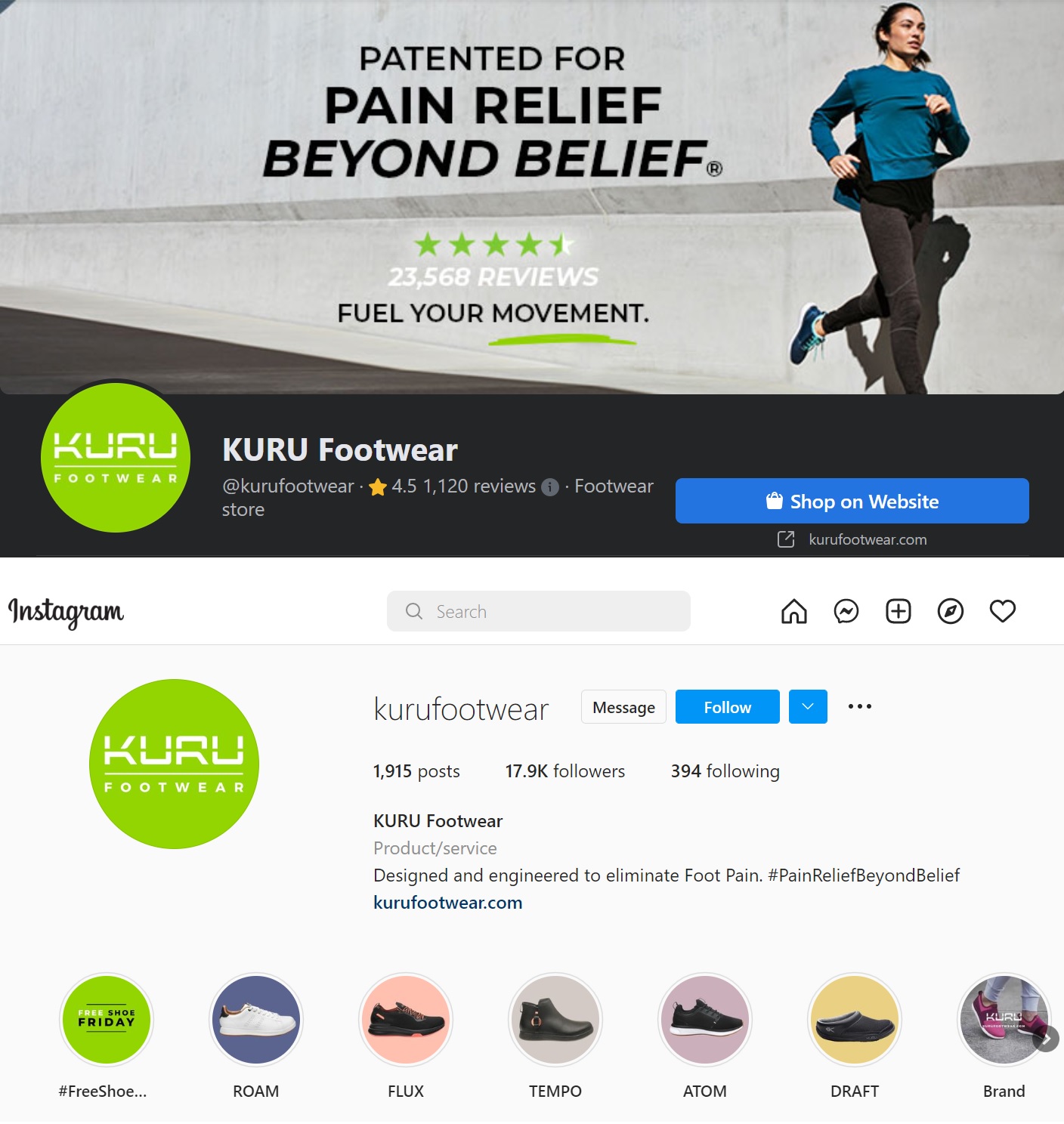
The company uses the same logo, handle name, and bio for its Facebook and Instagram accounts. Since Facebook has a separate About page, they use the banner to include their core message, tagline, and the total number of positive reviews.
At first glance, their target audience will understand the brand’s core message and know where to buy the best shoes for foot pain relief.
It would be best if you also focused on establishing a solid brand voice through your social media content (including captions and related copy). If you already have a brand voice for your marketing campaigns, you can use it on your social platforms. It will humanize your brand and naturally pull your customers in.
Sharing relatable and non-promotional social media content is the key to achieving absolute brand awareness. Also, ensure to post content on a consistent schedule.
Aside from building brand awareness and recognition, there are other goals you can use that focus on specific purposes. Whatever you choose will make your brand more popular among your target audience. I’ve listed a few of the objectives you can use as goals.
- Improve customer service
- Broaden customer reach
- Generate more leads and sales
- Boost community engagement
2. Understand Your Social Media Audience
Targeting the right audience on social media platforms will help you dominate your niche. You can create high-quality social media posts and ad campaigns relevant to your audience’s interests. As a result, it will generate higher conversion rates and better return on investment (ROI).
It also helps strengthen your brand’s voice and identify the social media platforms your customers and prospects use the most. If you have existing buyer personas, you can use them. But if none, you can create a set based on your audience’s demographics, including pain points and buying triggers.
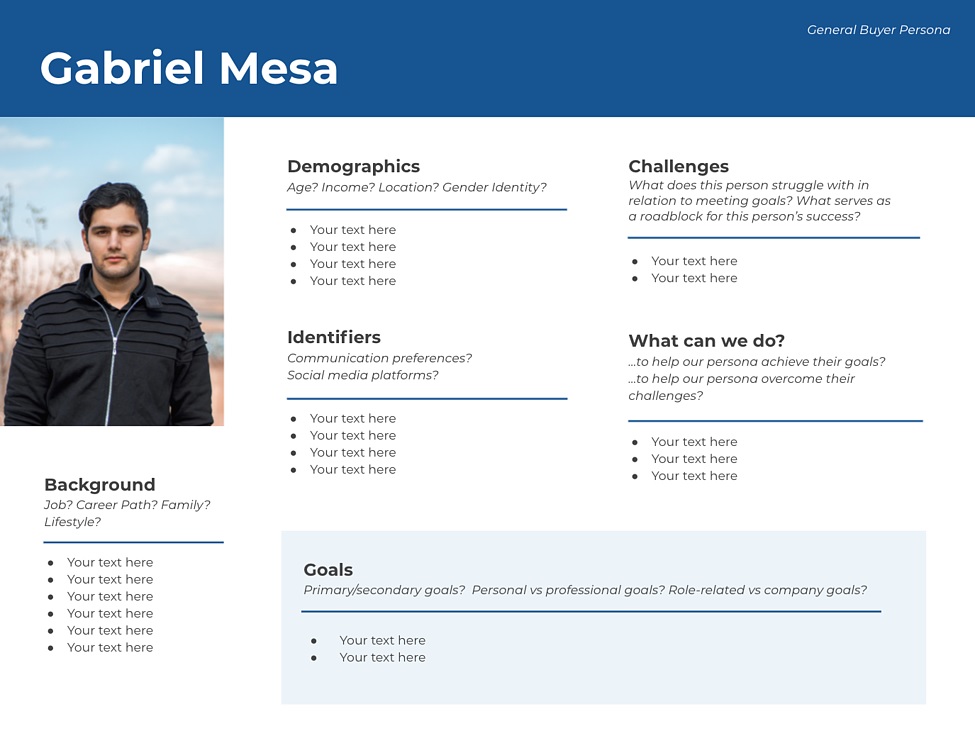
Image Source: Hubspot
The screenshot above is a sample template you can use to create your first buyer persona. It primarily focuses on the basic demographic information of your prospects. But you can freely add more data if you want a more targeted persona.
3. Research & Locate Your Social Media Audience
Now that you know what it can do for your brand, let’s find out how you can find your target audience. Many methods are available, and I’ll start with the simplest.
A. Run Surveys
The simplest method you can use is creating engaging surveys. A one-question poll is the most popular option because it receives higher completion rates. You can include two to five choices to get a definitive answer.
The good news is you can also make the answering process easier. You can present the answers in the form of multiple-choice or checkboxes. The open-ended survey is perfect to use if you want to get a detailed answer from your audience.
This type of survey question includes a text box under the question. I’ve shared a sample screenshot to give you a clear picture of what it looks like.

The only downside of the open-ended survey is the difficulty of analyzing the data. Since the audience uses their own words, you need to tally the answers manually. This isn’t fully a disadvantage, in my opinion, because you can discover many opportunities you will never get on surveys with pre-set answer options.
B. Explore Web Demographic Data
Finding and analyzing the demographic information is the key to understanding which social network and ad campaign you need to prioritize. Google Analytics is the popular option for determining your website users’ demographics. It tracks the site’s performance and determines who the users that interact with your content and web pages are.
You can start the process by enabling the demographics reporting on your site. You can log in to your Google Analytics account and navigate Admin > Property Settings. Scroll down until you see the Demographics and Interest Reports under Advertising Features and tick the ON/OFF switch to enable the option.
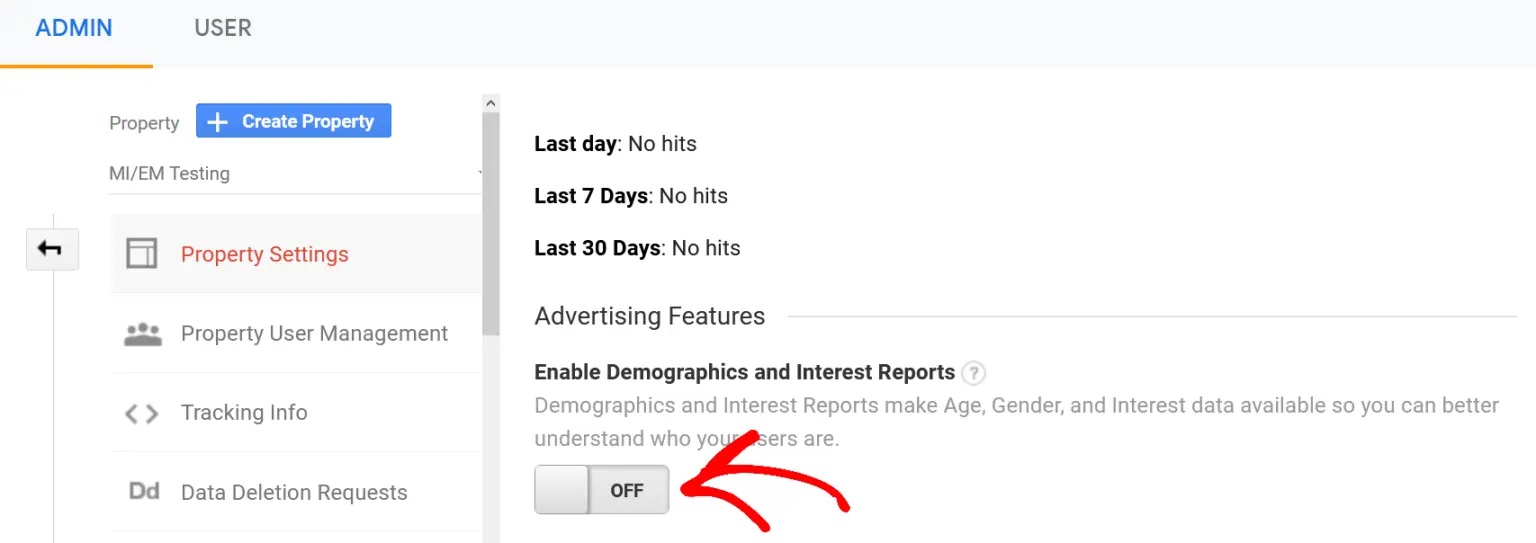
Doing so will allow you to view the demographics reports (see Insights > Reports > Publishers). The standard reports show you the age group and gender. But of course, you can customize it to get the necessary information.
You can do it by creating segments. You can create three segments, and I’ve listed them to give you a clear idea.
- Affinity categories are used to reach prospects based on their habits, interests, and everything they’re passionate about.
- In-Market segments are used to reach prospects based on their recent purchase intent.
- Select other categories for all insights that don’t fit the previous two’s requirement
- Interests overview are all the key metrics shown in affinity categories, In-Market segments, and other categories.
4. Watch Out For Social Media Demographic Data Too
Another way to get relevant demographic insights is by analyzing social media statistics. Statista is one of the many online platforms you can trust. Let’s explore Statista’s Facebook users worldwide.

Currently, the largest age group that uses the social channel ranges between 25 to 34 years old, both male and female. You can search for more statistics to find the user’s time spent per day and the type of content they are interested in.
5. Stay on Top of Industry Trends
Another excellent strategy to add to your social media marketing plan is staying up-to-date with the industry trends. It will help you uncover the interest of your target audience, new tools to use, and the community to reach out to. Not only will this help you get ahead of your competitors, but it will also help you get more ideas on how to treat customers professionally.
Keeping up with the industry trends may seem challenging because new trends are coming out every day. No need to worry because I’ve listed down all the online resources you can access for free.
- Sign up for the newsletter and other email campaigns of top marketing companies
- Read social media news sites
- Get hints from the website and social media marketing analytics (Google Trends, Moz Pro, Semrush, etc.)
- Find top influencers or experts in your field and subscribe to their YouTube channels.
- Listen to social media marketing podcasts
- Join relevant groups and forums related to social media marketing
- Speak directly to customers (social media followers) and gather quality feedback
Assuming you’ve gathered all the needed trends, the next step is to align them with your business and marketing goals. If you don’t know how to implement a specific industry trend, do not worry. Marketing companies and industry experts offer free and paid online training courses.
Choose the training course most suitable for your needs and sign up.
Pro Tip: Stay Alert With The Latest Industry Trends Using Google Alerts
Reading too much information can be incredibly overwhelming. Only read what matters to your brand with the help of Google Alerts. As the name implies, Google Alerts will notify you when new results show up in Google Search that are relevant to your brand.
News, brand name mentions, and products are some of the information you can get. Creating an alert is easy. Visit Google Alerts and input the topic you wish to follow.
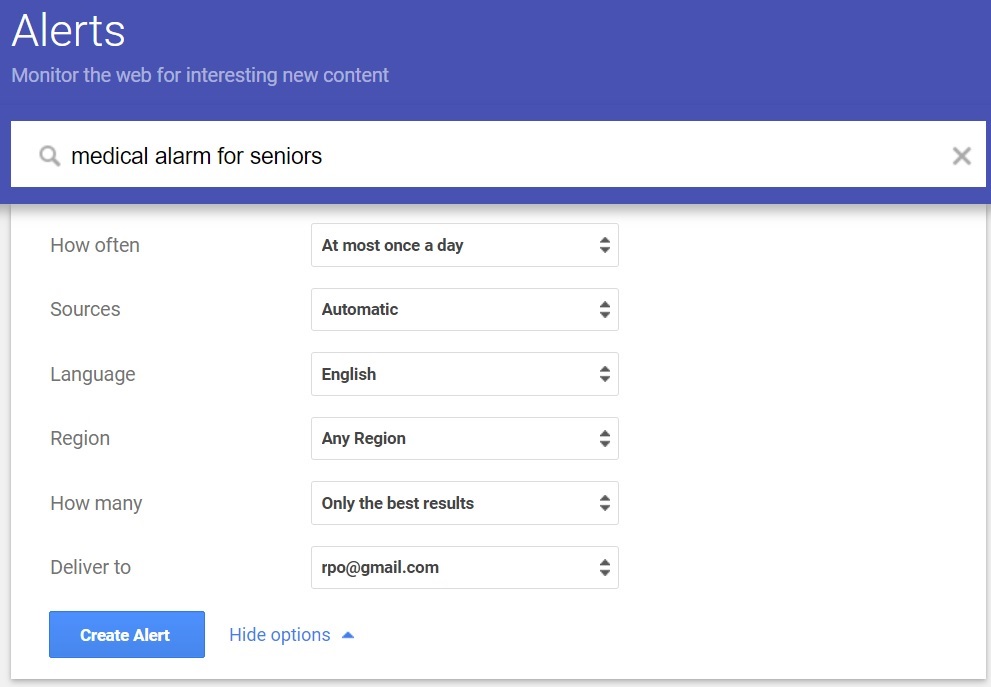
To give you an idea of how it works, I entered medical alarm for seniors as the sample topic to follow. Click the Show options to customize the notification. After completing the form, click the Create Alert button.
6. Create Platform-Specific Social Media Marketing Strategies
Now that you have identified which social media platforms your target audience uses, the next step is educating yourself about the platform. You need to know what type of content works and how your audience engages with the platform. Social media platforms have unique strengths, and uncovering them will help you create quality content that piques everyone’s interest.
I. LinkedIn
If you want to position yourself as an industry leader, LinkedIn is the best social network to join. It allows you to post content that can help professionals advance their careers or simply inspire them. You can also help companies to find and hire talented app developers and other experts in a specific field.
Publishing long-form content once or eight times a month is recommended. The more you publish, the better result you will achieve. Not only will it strengthen your brand’s credibility, but it will also help you build an engaged audience.
Your content may include pure text, creative graphics, and videos. If you don’t have a specific topic, you can share third-party content from reliable sources (Forbes articles, for example). You can use its content suggestion feature to help you identify relevant topics.
When choosing online resources, select one with a top-level domain name. Not only is it more noteworthy, but it also appears more legitimate and trustworthy. Besides publishing content on your profile, you can take advantage of other features on LinkedIn.
There are five features you can align with your content marketing strategy. I don’t want to bore you with too much information, so I will share a screenshot of their complete content marketing tactical plan.
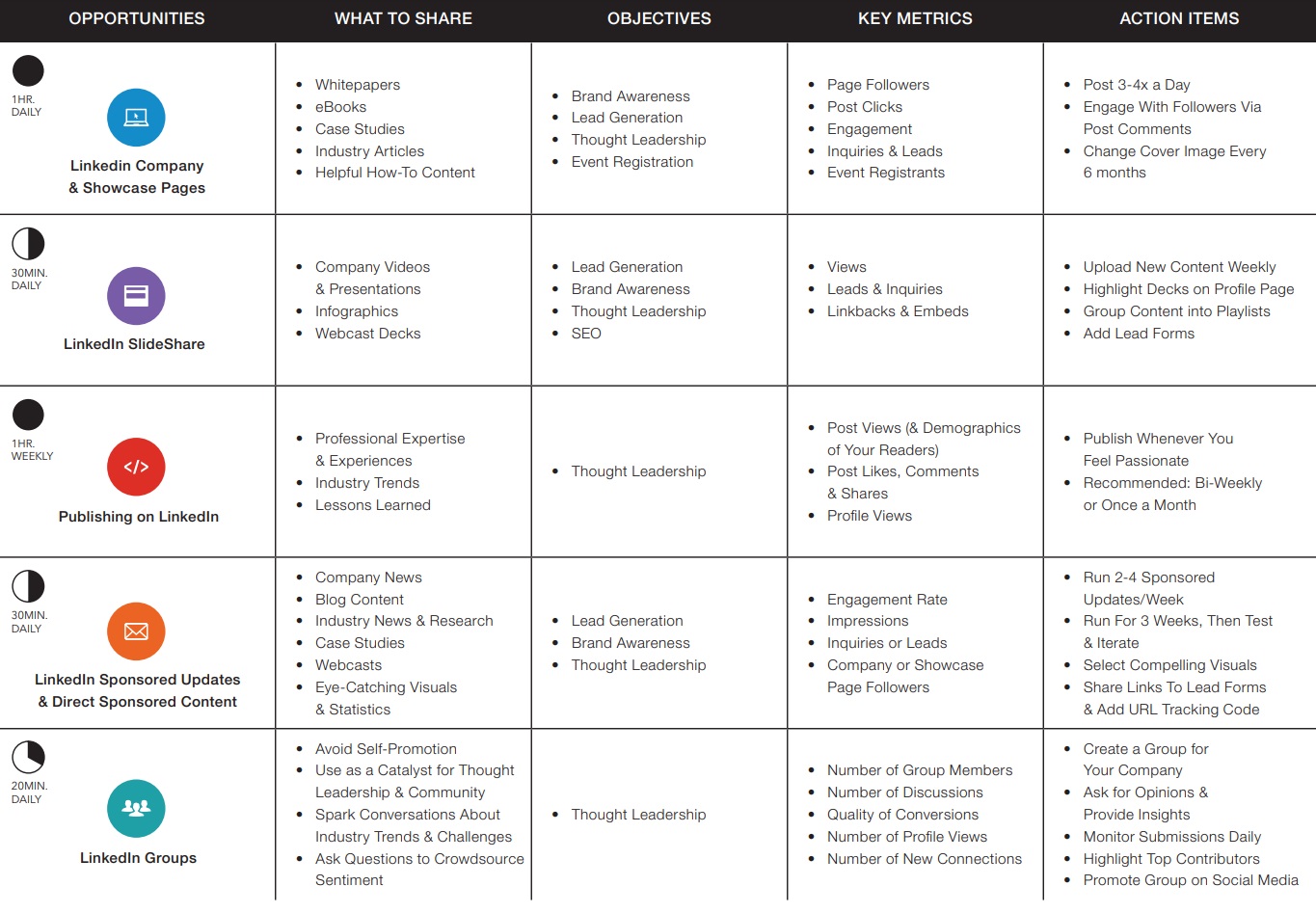
Pro Tip: Shorten Long URLs
Shorter URLs are easier to share and read. You can shorten long URLs using Bitly or use a smart, short, and unique domain name with the .cyou domain extension.
II. TikTok
TikTok is undeniably one of the fastest-growing social media marketing platforms today. It now acquires a whopping 1+ billion monthly active users, mainly Gen Z and millennials. Like most social media platforms, you can use this social channel as an invaluable digital marketing tool.
It rose to fame for sharing short-form on-demand videos. But you can mix it up with live videos to ensure you can connect with your audience in real-time. Regarding the type of content you need to share, entertainment-focused content is the fan favorite.
You can incorporate this idea into your content strategy to boost your social media presence. You can also solidify your brand voice and engage communities by featuring product reviews and other user-generated content (UGC).
Though TikTok popularized a specific video format, you don’t need to limit yourself to it. You can create your own social content that matches your brand’s vision and business goals. Ensure it’s creative, fun, and relatable to your target audience.
Getting started is easy. Select the business size (small or large), then proceed in creating a TikTok Business account. It will redirect you to the Ads Manager, where you can select your goals, audience, budget, and design your ad (see screenshot below as reference).
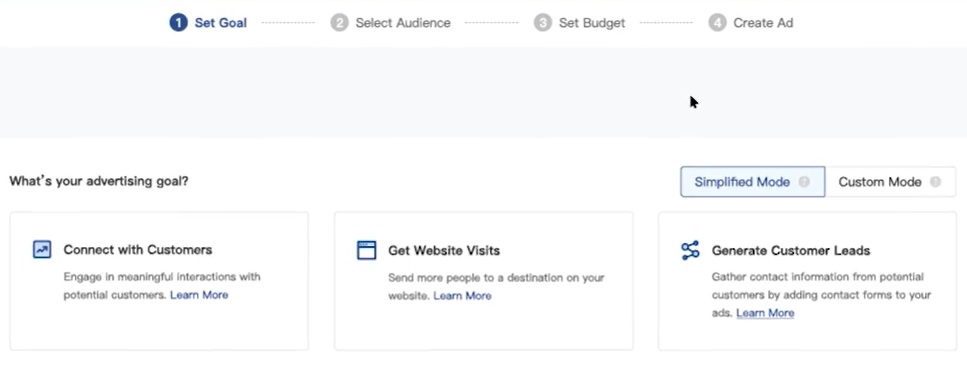
III. Snapchat
Snapchat may not constantly be on the latest trend list, but it remains a competitive platform for establishing business credibility and building an engaged audience. Statista research shows it remains on the top 15 most used social media marketing platforms.
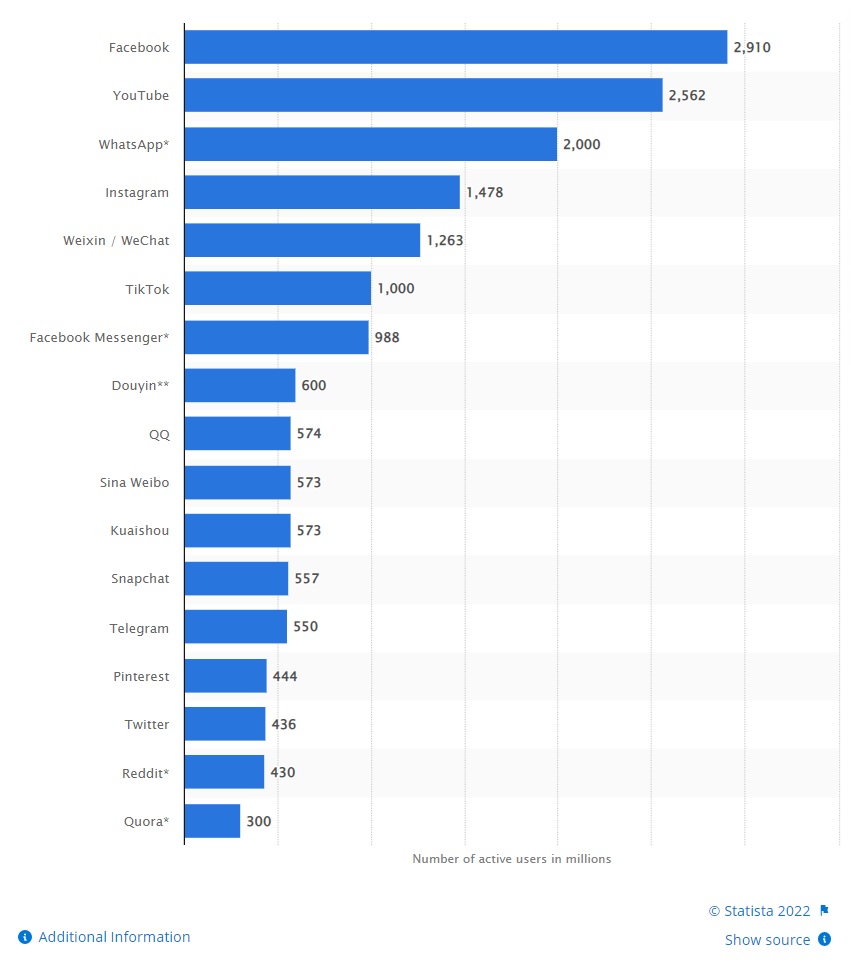
Image Source: Statista
Like TikTok, you can also leverage user-generated content (UGC). For example, a customer purchased sheer babydoll lingerie from your store. You can encourage them to send you their unboxing video. Offer free perks to entice them even more.
Creators, influencers, and brands also use this social channel to feature events, products, and lifestyles. Aside from posting video content, you can also advertise on the platform. Currently, there are four ad formats you can use.
- Snap ads
- Collection ads
- Story ads
- Dynamic ads
7. Maximize Social Media’s Features
Don’t focus on its popular features when familiarizing yourself with the social media platform. Explore all its functionalities so you can decide wisely on which one to use when planning your content and social strategy. Let’s take Twitter, for example.
The social media marketing strategies for Twitter primarily focus on boosting engagement through conversations. Therefore, you must generate a healthy combination of organic tweets, retweets, and replies. You can use the pinned tweets feature to gain more visibility and click-through.

Pinning a tweet will keep it on the top of your profile. When you pin a tweet, ensure that the content has a solid visual, an on-point call to action, and a link leading to its source (website, blog, etc.). Adding relevant keywords and hashtags is also recommended to widen your audience reach.
Most brands use Twitter to announce new products and event updates. But did you know that Twitter is also one of the best social channels for promoting podcasts? It’s true, and you can use Twitter Space for it.

Twitter Space works by allowing everyone to use their own voice to connect. This certainly frees your audience from the 140-character count restriction. Podcasters commonly use it to do Q&As, promote a new/returning show, or listen to the fans’ feedback.
Twitter includes a simple tutorial to make the setup process more manageable. I’ve also shared a guide on how to start a podcast to save time.
8. Make Your Social Media Messages More Impactful
Social media marketing allows you to connect with your target audience on a personal level. So, ensure to captivate them with lively and engaging social posts that inform and entertain. Don’t forget to incorporate your brand’s goals into the message to reinforce your brand voice.
Creating multiple contents can be very challenging. But you can make it easier by creating a social media theme. A theme is an excellent way to provide a good structure for your content calendar.
You can set a specific theme daily, weekly, or monthly. Another method you can use is following the 80-20 rule. This means that 80% of your social posts must be dedicated to educating and entertaining, and 20% is intended for brand promotion.
Errors in social media content can ruin its core message. Ensure to proofread it before hitting the publish button. You can use AI writing software like Grammarly to help you correct spelling and grammar errors.
9. Utilize The Right Social Media Marketing Tools
Managing different social media platforms can be time-consuming and exhausting. Ensure to stay productive using only the right tools. First on the list is social media management tools.
It’s a total lifesaver because it will streamline all social media activities, data, and conversations in one secure location. Hootsuite and Sprout Social are the two popular options available today. They both support a wide variety of social networks and promote effective collaboration.
The good news is that there are more tools available in the market, most of which are developed to save time. I’ll explain each briefly to give you an idea of its purpose. Pick the right tools that can boost your productivity and efficiency.
- Automation: This allows you to post or repost content at similar times every day.
- Pitch deck builder and templates: Makes the pitching of ideas simpler.
- Analytics: Provide quality insights that can help you drive traffic in the right direction.
- Video content management software: Manage, store, and upload video content directly to your social media.
- Social media calendar: Determine the best times to post content and create a schedule for you not to miss any opportunities.
- Website plug-ins: Select additional plug-ins for your landing pages to boost engagement and conversion rate. Video pop-ups are a popular option because they can receive up to a 20% increase in engagement rate.
Wrapping Up
Now that more than half the world’s population uses social media, it’s the best time to update your marketing strategy. Building winning social media marketing strategies doesn’t always have to be challenging. Remember to focus on your target audience’s needs and satisfaction when creating content.
Also, stay consistent in publishing relevant content for the audience to remember you. Posting on a consistent schedule is also recommended. This is an excellent way to give your followers something to look forward to daily.
When it comes to widening your customer base, brand collaboration remains the most effective strategy. You can reach out to influencers or other brands via email and pitch them your ideas. Ensure to keep it concise and clear (up to 100 words) to avoid misinterpretation.
Don’t forget to personalize your messages and establish realistic expectations. Influencers and brands receive tons of pitches all the time. Ensure you will not kill your chance by sending messages that don’t match their audience’s needs or content.
Using social media marketing for business is one of the best ways to make a good fortune online. Make sure to follow the best practices to ensure success. If you have more social media marketing strategies to share, leave them in the comment section.
About Author

Burkhard Berger is the founder of Novum™. Follow Burkhard on his journey from $0 to $100,000 per month. He’s sharing everything he learned in his income reports on Novum™ so you can pick up on his mistakes and wins.
